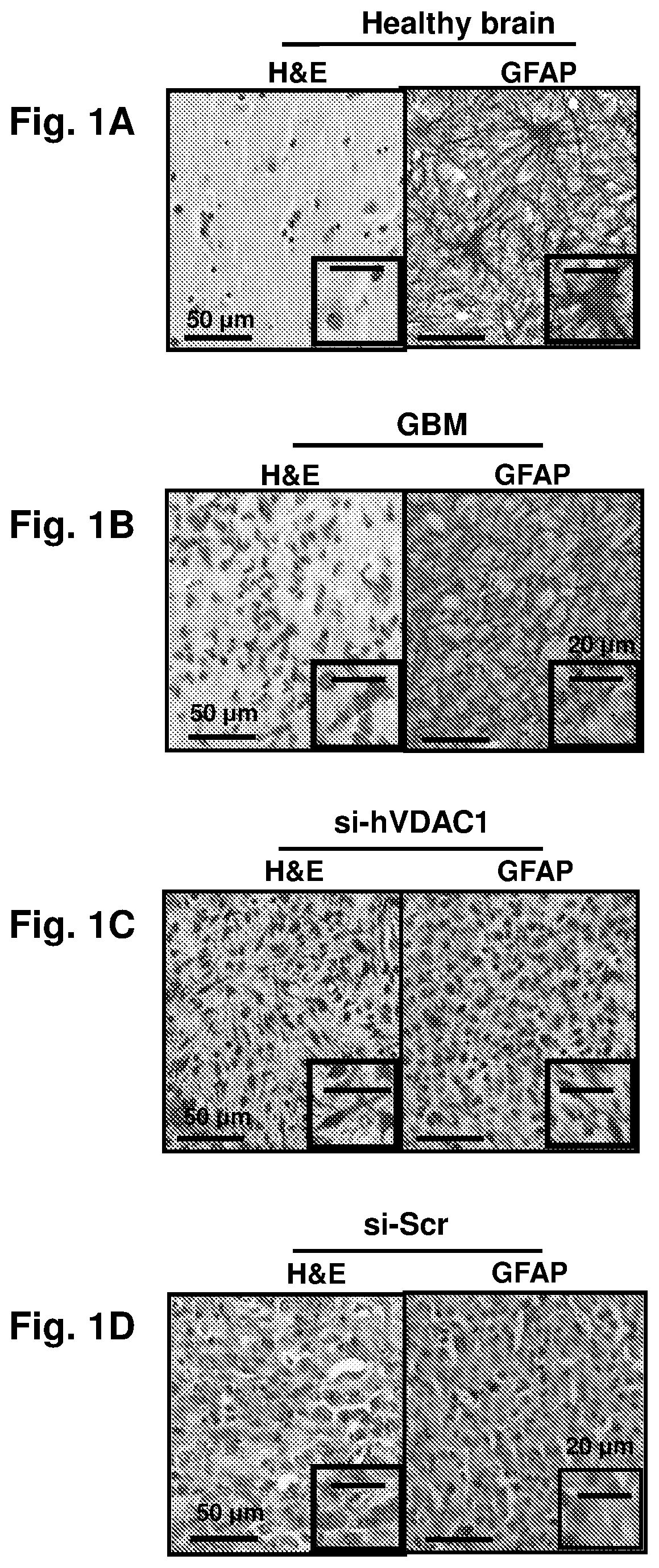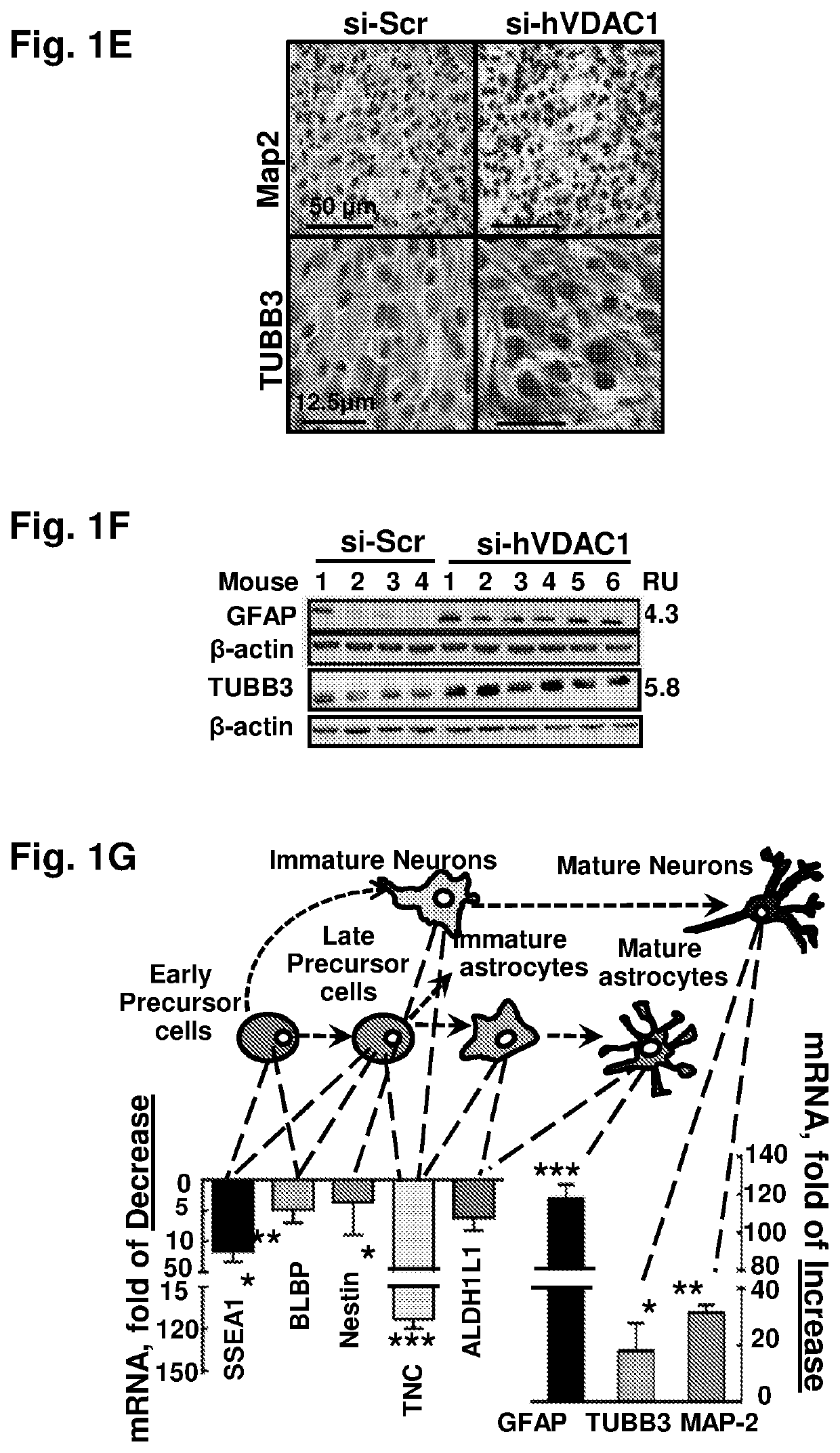Means and methods for reducing tumorigenicity of cancer stem cells
a stem cell and tumorigenicity technology, applied in the direction of biochemistry apparatus and processes, organic active ingredients, drug compositions, etc., can solve the problems of slow growth of stem cells, inability to respond, current approaches to tumor treatment many times do not prevent recurrence, etc., to reduce the tumorigenicity of tumors and reduce the recurrence of said tumors
- Summary
- Abstract
- Description
- Claims
- Application Information
AI Technical Summary
Benefits of technology
Problems solved by technology
Method used
Image
Examples
example 1
letion Induces Changes in Cell Morphology and Expression of Differentiation Associated Proteins
[0209]The levels of several differentiation markers in si-Scr and si-hVDAC1-treated tumors (TTs) were examined. As GBM is often considered a grade IV astrocytoma in which astrocytes lack normally recognizable features, human normal brain and GBM sections were hematoxylin and eosin (H&E) stained Normal brain showed astrocytes, a few small vessels and mainly fibrillary stroma (FIG. 1A). In contrast, GBM sections showed large irregular cells with atypical nuclei (FIG. 1B). Staining of normal brain for GFAP (glial fibrillary acidic protein), an intermediate filament protein expressed by central nervous system cells, including astrocytes, showed cells with long and marked processes (FIG. 1A). GFAP-staining of GBM sections showed cells with no processes, emphasizing the highly malignant nature of the cancer (FIG. 1B).
[0210]H&E-stained si-Scr-TT sections revealed cells with large nuclei (FIG. 1D)...
example 2
letion Alters Transcription Factor (TF) Expression Profiles
[0212]To better understand the molecular mechanism underlying cell signaling and gene expression altered by treating the tumor with si-hVDAC1, shown to be leading to cell differentiation, changes in the expression levels of transcription factors (TFs) in the nuclear fraction were screened for. Cancer stem cell TF activation profiling plate array was used (FIG. 3A). si-hVDAC1-TTs expressed increased levels of tumor suppressor TFs, such as p53, Forkhead box O3 (FoxO3), PR domain-containing 14 (PRDM14) and signal transducer and activator of transcription 3 (STAT3). Expression levels of the major TFs p53, HIF-1α and c-Myc, known to regulate metabolism, cell growth, proliferation and differentiation (Yeung S J et al. 2008. Cellular and molecular life sciences: CMLS 65, 3981-3999) were significantly affected by si-hVDAC1 treatment. p53 levels were elevated in si-hVDAC1-TTs, while the expression levels of HIF-1α and c-Myc were redu...
example 3
atment with Si-hVDAC1 Eliminates Glioblastoma Stem Cells (GSCs)
[0215]The decrease in the levels of transcription factors (TFs) associated with stemness in the si-hVDAC1-TTs, such as Oct-3 / 4, AP1(Jun), Twist and Klf4 (FIG. 3A), and the increase in cell differentiation markers (FIG. 1) led to further analyses of the effects of VDAC1 depletion on the expression of GSCs-associated markers (FIG. 3E-H). Dynamic steadiness between self-renewing GSCs and differentiation is essential for GBM development (Bao et al., 2006) and invasion (FIG. 4A,B) (Singh et al., 2004). si-hVDAC1 treatment markedly decreased the expression of GSCs markers, such as CD133, Sox2, Klf4, Musashi, Nestin, NGFR, S100b and CD44, as evaluated by IHC and WB (FIG. 3E-G) and qRT-PCR, revealing decreases of several fold in Sox2, Oct3 / 4 and Nanog mRNA levels (FIG. 3H). Similar results were obtained with U-118 xenografts (FIG. 4C,D). The orthotopic tumors derived from si-Scr-treated U-87MG cells showed high levels of Nestin ...
PUM
| Property | Measurement | Unit |
|---|---|---|
| volume | aaaaa | aaaaa |
| depth | aaaaa | aaaaa |
| echo time | aaaaa | aaaaa |
Abstract
Description
Claims
Application Information
 Login to View More
Login to View More - R&D
- Intellectual Property
- Life Sciences
- Materials
- Tech Scout
- Unparalleled Data Quality
- Higher Quality Content
- 60% Fewer Hallucinations
Browse by: Latest US Patents, China's latest patents, Technical Efficacy Thesaurus, Application Domain, Technology Topic, Popular Technical Reports.
© 2025 PatSnap. All rights reserved.Legal|Privacy policy|Modern Slavery Act Transparency Statement|Sitemap|About US| Contact US: help@patsnap.com



